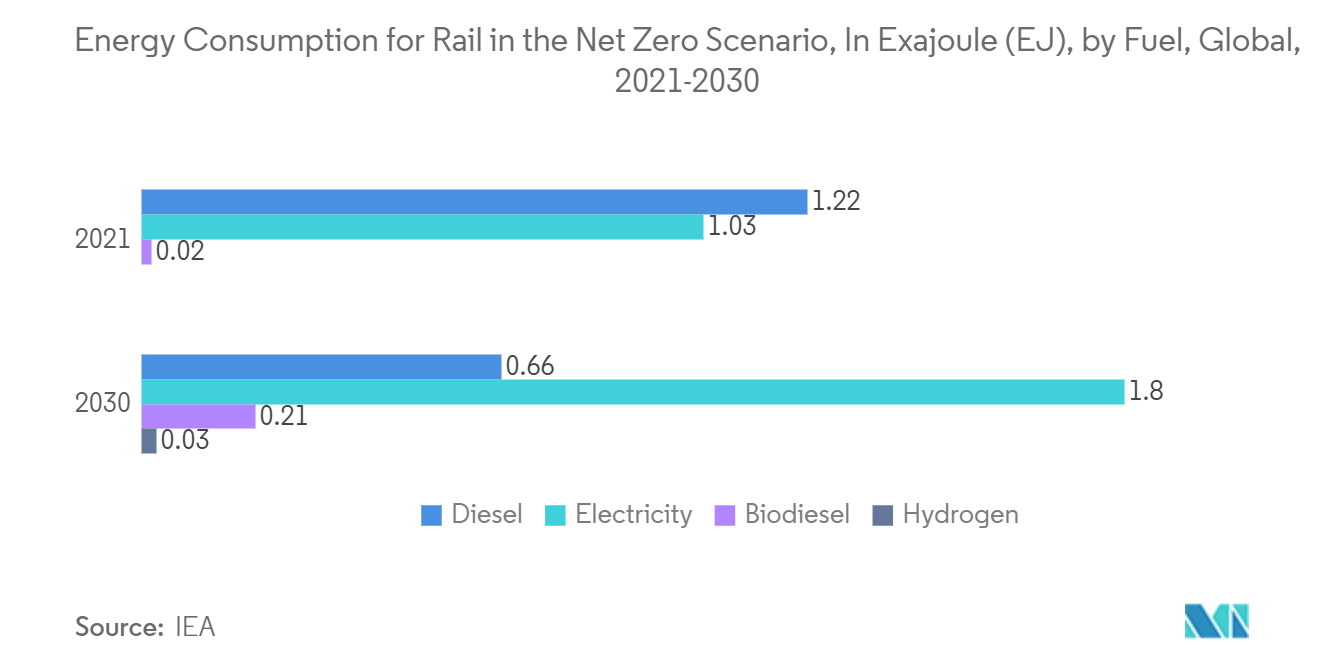Market Trends of Rail Asset Management Industry
Growing Demand for Effective Rail Operations to Drive the Market
- Rail transportation is known for its efficiency in moving large volumes of goods and passengers over long distances. It offers advantages such as high capacity, lower energy consumption per unit of freight or passenger, and reduced traffic congestion compared to other modes of transportation. As the demand for transportation continues to rise, the need for efficient rail operations becomes more crucial.
- Moreover, rail transportation is experiencing a surge in demand due to several factors, such as urbanization, population growth, and the need for sustainable transportation options. As more passengers and goods rely on rail services, efficient and reliable operations are needed. Effective rail asset management enables operators to enhance capacity, optimize scheduling, and ensure smooth operations to accommodate increased rail traffic.
- Rail transportation is considered more environmentally friendly compared to road or air transport. Trains produce lower greenhouse gas emissions per ton-mile or passenger-mile, contributing to reduced carbon footprints. For instance, according to the International Energy Agency (IEA), in the Net Zero Scenario, by 2030, electricity is anticipated to account for around two-thirds of the total final energy consumption. Diesel and biodiesel account for the remaining three quarters. Hydrogen penetration is expected to be minimal. With increasing awareness of climate change and the need for sustainable transportation options, rail operations are seen as an attractive solution.
- Furthermore, advancements in technology are revolutionizing rail operations. Automation, digitalization, and data analytics improve asset management, predictive maintenance, optimized scheduling, and enhanced safety measures. These technological advancements are driving the demand for effective rail operations to leverage the benefits of innovation.
- Demand for effective rail operations drives technology adoption and data-driven solutions for rail asset management. This includes implementing asset management software, sensor-based monitoring systems, and predictive analytics tools. These technologies enable better asset tracking, real-time performance monitoring, and data-driven decision-making, improving operational efficiency and cost savings.
- Overall, the increasing demand for effective rail operations transforms the rail asset management market. It drives investment, promotes technological advancements, emphasizes asset performance and safety, and creates opportunities for market expansion. Rail asset management becomes a critical component in meeting the evolving needs of the rail industry and ensuring efficient and reliable rail operations.

Asia-Pacific to Witness Significant Growth
- The Asia-Pacific region is anticipated to grow significantly during the forecast period due to the emerging economies and the increasing governmental focus in the countries such as India, China, and Japan. This creates an opportunity for market vendors to expand their businesses in the APAC region, driving the rail asset management solutions market. For instance, in April 2023, the Siemens consortium and Gujarat Metro Train Corporation partnered to create advanced train electrification solutions, in which Siemens is expected to manage the project to implement power supply, train electrification technology, and distribution systems.
- The rolling stock segment has been registering significant growth in the Chinese market because enterprises in the rail industry have been increasingly adding advanced strategies. According to Railtech, more than 3,000 kilometers of new railway lines were expected to be operated in China in 2022, including 2,500 kilometers of high-speed railways. This will increase the demand for rail asset management, as this will help enable strategic decision-making for long-term planning and investment.
- With its large network, rail asset management in India faces several challenges that impede its efficiency and effectiveness. One significant challenge is the vast size and complexity of the railway network, which spans over 67,000 kilometers and comprises diverse assets, including tracks, bridges, signaling systems, rolling stock, and stations. Managing and maintaining these assets requires meticulous planning, resource allocation, and coordination. Hence, developing a centralized asset inventory includes detailed information on all railway assets, such as age, condition, maintenance history, and performance data. This inventory will serve as a foundation for effective asset management planning.
- Japan's railway system is renowned worldwide for its efficiency, reliability, and advanced technology. As the country continues to experience population growth, urbanization, and increased transportation demands, rail asset management has emerged as a critical aspect of maintaining and optimizing the railway infrastructure.
- The Rest of the Asia-Pacific includes Australia, South Korea, Thailand, and others. The asset management market in Australia has experienced significant growth and increasing demand in recent years, making it an attractive market for rail asset management solutions.


